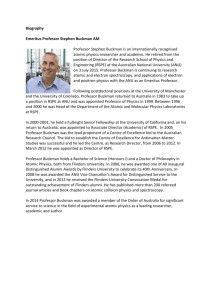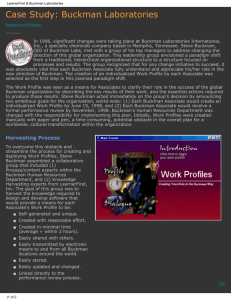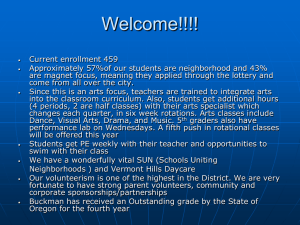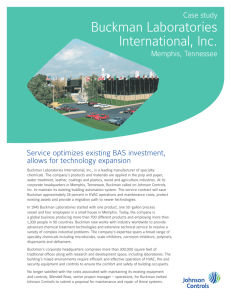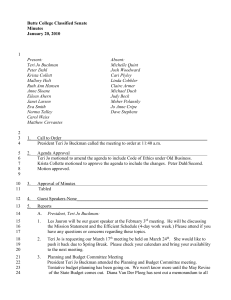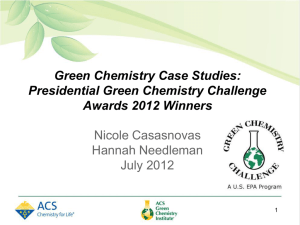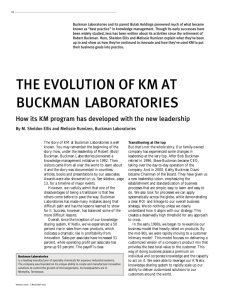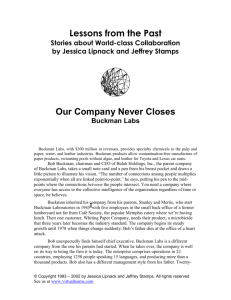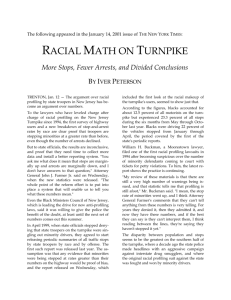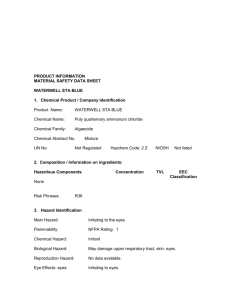Buckman Labs Is Nothing but Net
advertisement
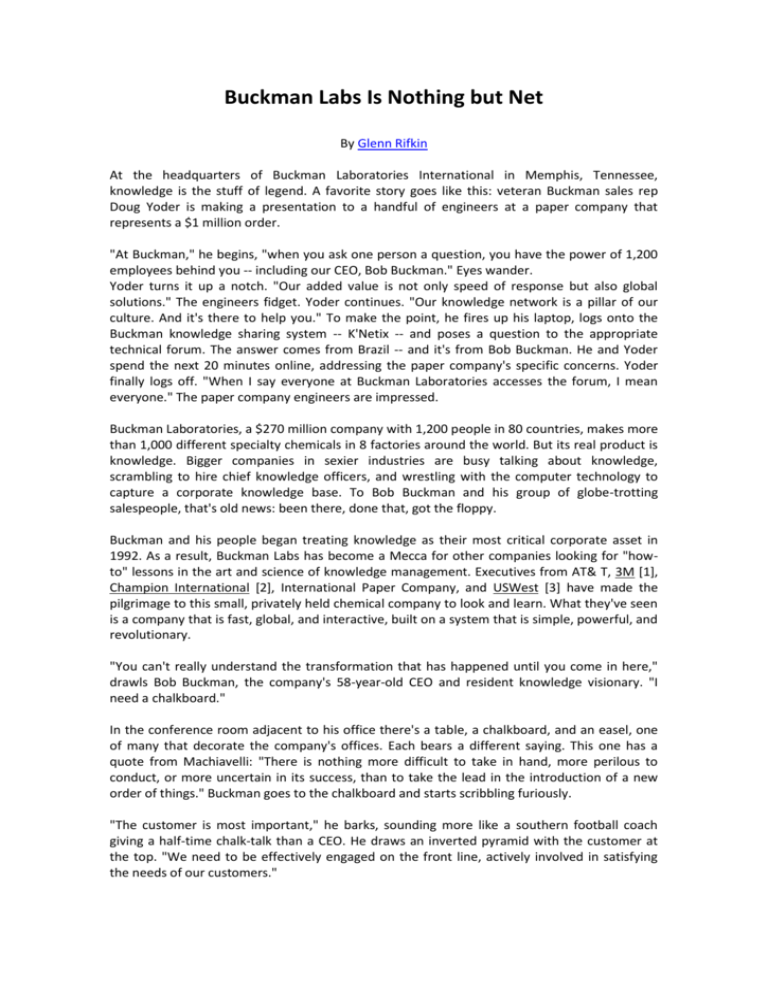
Buckman Labs Is Nothing but Net By Glenn Rifkin At the headquarters of Buckman Laboratories International in Memphis, Tennessee, knowledge is the stuff of legend. A favorite story goes like this: veteran Buckman sales rep Doug Yoder is making a presentation to a handful of engineers at a paper company that represents a $1 million order. "At Buckman," he begins, "when you ask one person a question, you have the power of 1,200 employees behind you -- including our CEO, Bob Buckman." Eyes wander. Yoder turns it up a notch. "Our added value is not only speed of response but also global solutions." The engineers fidget. Yoder continues. "Our knowledge network is a pillar of our culture. And it's there to help you." To make the point, he fires up his laptop, logs onto the Buckman knowledge sharing system -- K'Netix -- and poses a question to the appropriate technical forum. The answer comes from Brazil -- and it's from Bob Buckman. He and Yoder spend the next 20 minutes online, addressing the paper company's specific concerns. Yoder finally logs off. "When I say everyone at Buckman Laboratories accesses the forum, I mean everyone." The paper company engineers are impressed. Buckman Laboratories, a $270 million company with 1,200 people in 80 countries, makes more than 1,000 different specialty chemicals in 8 factories around the world. But its real product is knowledge. Bigger companies in sexier industries are busy talking about knowledge, scrambling to hire chief knowledge officers, and wrestling with the computer technology to capture a corporate knowledge base. To Bob Buckman and his group of globe-trotting salespeople, that's old news: been there, done that, got the floppy. Buckman and his people began treating knowledge as their most critical corporate asset in 1992. As a result, Buckman Labs has become a Mecca for other companies looking for "howto" lessons in the art and science of knowledge management. Executives from AT& T, 3M [1], Champion International [2], International Paper Company, and USWest [3] have made the pilgrimage to this small, privately held chemical company to look and learn. What they've seen is a company that is fast, global, and interactive, built on a system that is simple, powerful, and revolutionary. "You can't really understand the transformation that has happened until you come in here," drawls Bob Buckman, the company's 58-year-old CEO and resident knowledge visionary. "I need a chalkboard." In the conference room adjacent to his office there's a table, a chalkboard, and an easel, one of many that decorate the company's offices. Each bears a different saying. This one has a quote from Machiavelli: "There is nothing more difficult to take in hand, more perilous to conduct, or more uncertain in its success, than to take the lead in the introduction of a new order of things." Buckman goes to the chalkboard and starts scribbling furiously. "The customer is most important," he barks, sounding more like a southern football coach giving a half-time chalk-talk than a CEO. He draws an inverted pyramid with the customer at the top. "We need to be effectively engaged on the front line, actively involved in satisfying the needs of our customers." "We need to cut the umbilical cord," he continues -- a reference to the mainframe mentality that kept people tied to the office. Buckman rattles off the numbers. "If you work a 40-hour week, you're in the office less than 25% of your time. If you travel 40% of the workweek, you're in the office less than 15% of your time. And if you're a salesperson, you're in the office 0% of your time." Part techno-visionary, part hard-nosed businessman, Bob Buckman poses the challenge of competition in the knowledge-intensive '90s: Close the gap with the customer. Stay in touch with each other. Bring all of the company's brainpower to bear in serving each customer. "The real questions are," says Buckman, "How do we stay connected? How do we share knowledge? How do we function anytime, anywhere -- no matter what?" The Real Power of Knowledge The answer that Bob Buckman came up with was the knowledge network -- K'Netix. It came to him eight years ago, when he was flat on his back, confined to bed after rupturing his back. Unable to get up, unable even to sit up, Buckman propped a laptop computer on his belly and took dead aim on the real power of knowledge. "Lying there thinking how isolated I was," says Buckman, recalling his two weeks in bed. "I got to thinking about what I wanted." What he wanted was information, not just for himself but for all his people, a steady stream of information about products, markets, customers. And he wanted it to be easily accessible, easily shared. A relentless student of business and management writing, he had recently read a comment from Jan Carlzon, the former head of SAS, and it had struck a chord with him: "An individual without information cannot take responsibility; an individual who is given information cannot help but take responsibility." "If you can't maximize the power of the individual, you haven't done anything," Buckman thought. "The basic philosophy is, How do we take this individual and make him bigger, give him power? How? Connect him to the world." On his laptop, Buckman wrote his ideal knowledge transfer system: It would make it possible for people to talk to each other directly, to minimize distortion. It would give everyone access to the company's knowledge base. It would allow each individual in the company to enter knowledge into the system. It would be available 24 hours a day, 7 days a week. It would be easy to use. It would communicate in whatever language is best for the user. It would be updated automatically, capturing questions and answers as a future knowledge base. Such a system, he realized, would mean a cultural transformation. It would mean turning the company upside down. Which was precisely what he wanted to do - and had wanted to do since 1961 when he'd joined the company his father had founded. With a degree in chemical engineering from Purdue University [4] and an MBA from the University of Chicago [5], Buckman had long been fascinated by organizational dynamics and the potential for change that computers had created. And he'd chafed working under his father, Stanley, who epitomized the classic pyramid-style leader: he oversaw every decision, sales order, check, memo. In 1978, at the age of 69, Stanley Buckman suffered a heart attack and died on his office couch, and the reins of control passed to Bob. "I knew I didn't want to do it his way," Buckman says. "Everything went through my father. The general managers of our different ventures had never even met each other. I thought, this is too much work." His epiphany showed him the path to the future. "I realized that if I can give everybody complete access to information about the company, then I don't have to tell them what to do all the time," he says. "The organization starts moving forward on its own initiative." The knowledge network would become the organization. But first he had to create the organization to manage the knowledge network. In March 1992, Buckman set up a Knowledge Transfer Department and appointed Victor Baillargeon, then a 34-year-old PhD in organic chemistry, to run it. For a company that was determined to break the rules, Baillargeon was the perfect choice: he had spent the previous year as Buckman's assistant, researching the concept of knowledge transfer, and was eager to put the theories to the test. And he was no member of the card-carrying information technology fraternity; he came to the job free of mainframe baggage. Baillargeon's first hurdle was to build a network that was both ubiquitous and easy to access from around the world. With that in mind, Baillargeon suggested that the company put its entire worldwide network up on CompuServe, the public online service. CompuServe offered e-mail access to 35 public network services and the ability to create private bulletin boards for intracompany use. And all it took was a single phone call to connect. Baillargeon engineered the move to CompuServe in just 30 days. Every Buckman salesperson was given an IBM [6] ThinkPad 720 with a modem. For a total of $75,000 per month in access charges, all Buckman employees could make a single phone call that established a point-topoint link with headquarters and provided access to all of CompuServe's global information services. On that platform Baillargeon built K'Netix, the company's global knowledge transfer network, and established seven technical forums to organize the company's online conversations. That was four years ago. Today Buckman and his team have a clearer line of sight than most into what it means to do business in the knowledge economy. In particular, four categories of lessons emerge from Bob Buckman's knowledge laboratory: the importance of customer engagement; how to encourage knowledge-sharing; the value of values; and how to think about measurements. "Effectively Engage with the Customer" It's one of Bob Buckman's most repeated phrases: effectively engaged on the front line -- a constant reminder that knowledge transfer at Buckman Labs is not an end in itself. The whole point is to deploy knowledge at the point of sale -- to win business and to serve the customer. To Buckman, it all can be reduced to a simple ratio: "The number of people in the organization working on the relationship with the customer, relative to the total organization, will determine the momentum of the organization," he says. For that reason, the percentage of the company that is "effectively engaged with the customer" is data that Buckman tracks religiously. In 1979, before K'Netix was launched, it was a mere 16%. Today, it's about 50%. By the year 2000, Buckman says, it will be 80%. The message is simple: the front line and the bottom line have everything to do with each other. Buckman competes in a variety of businesses, from pulp and paper processing and water treatment, which makes up 60% of its sales, to leather, agriculture, and personal care. Arrayed against it are companies three to five times its size: $700 million Betz Laboratories of Trevose, Pennsylvania, for example, or $1.2 billion Nalco of Naperville, Illinois. And the industry is consolidating as customers like International Paper Company, Sherwin-Williams, Chinet, and Citgo, pare down their list of vendors to just a few -- from whom they expect more. Under these conditions, Buckman's commitment to knowledge takes on a new urgency. Salespeople must have the right answer for each customer -- and fast. K'Netix makes that an everyday occurrence, an exercise in speed, globality, and interactivity. Take the case of Dennis Dalton, who is based in Singapore as managing director of all company activities in Asia. According to the K'Netix archives, Dalton sent out a call for help last January 3 at 12:05 p.m.: "We will be proposing a pitch-control program to an Indonesian pulp mill," he wrote. "I would appreciate an update on successful recent pitch-control strategies in your parts of the world." The first response came three hours later, from Phil Hoekstra in Memphis, and included a suggestion of the specific Buckman chemical to use and a reference to a master's thesis on pitch control of tropical hardwoods, written by an Indonesian studying at North Carolina State University. Fifty minutes later Michael Sund logged on from Canada and offered his experience in solving the pitch problem in British Columbia. Then Nils Hallberg chimed in with examples from Sweden; Wendy Biijker offered details from a New Zealand paper mill; Jos* Vallcorba gave two examples from Spain and France; Chip Hill in Memphis contributed scientific advice from the company's R & D team; Javier Del Rosal sent a detailed chemical formula and specific application directions from Mexico; and Lionel Hughes weighed in with two types of pitchcontrol programs in use in South Africa. In all, Dalton's request for help generated 11 replies from six countries, stimulated several "sidebar conversations" as participants followed-up on new knowledge they'd just learned -- and catapulted Dalton into position to secure a $6 million order from the Indonesian mill. The customer focus of the knowledge system is built into the design of K'Netix. For some of Buckman's core customers, for example, there are private forums where the conversation is about only that customer and the advice is tailored to its needs. In addition, the Customer Information Center contains all available information about the company's customers, including internal memos, documents, and sales orders -- a complete file cabinet on each customer. "We have to be so tuned into our customers that we anticipate what they need," says Buckman. "If an employee is not effectively engaged with the customer, why are they employed?" Knowledge-Sharing Is Power Over the years, people have taught themselves to hoard knowledge to achieve power," says Buckman. "We have to reverse that: the most powerful people are those who become a source of knowledge by sharing what they know." But four years ago, when Buckman Labs launched its K'Netix program, the big unanswered question was, Would people share their knowledge? "There was a sense of hesitancy in the beginning," remembers Alison Tucker, 36, K'Netix forum manager. "There were people whose file cabinets were filled with everything they knew, and that was their source of power." Ultimately, what emerged was a carrot-and-stick balance, mixing visible incentives with invisible pressure, and an organization-wide bias toward teamwork and knowledge reciprocity. As one carrot, Buckman organized a one-time event in Scottsdale, Arizona at a fashionable resort as a celebration to recognize the 150 best knowledge-sharers. Those selected received a new IBM ThinkPad 755, a leather computer bag, and listened to a presentation by Tom Peters. Within the company, the high-profile event -- dubbed "The 4th Wave" -- sparked a good deal of discussion, particularly among those who failed to make the cut. The event served its purpose: in the weeks afterward, participation on the K'Netix forums increased dramatically. The stick component is a good deal more subtle but more pervasive: everyone in the company knows that Bob Buckman isn't just watching the knowledge net - he's constantly on it. Early in the life of K'Netix, Buckman laid out his expectations in a speech to his people. "Those of you who have something intelligent to say now have a forum in which to say it," he told them. "Those of you who will not or cannot contribute also become obvious. If you are not willing to contribute or participate, then you should understand that the many opportunities offered to you in the past will no longer be available." Knowledge Builds Trust, Trust Builds Knowledge For companies thinking about entering the knowledge economy, Bob Buckman emphasizes one lesson before all others: "What's happened here is 90% culture change. You need to change the way you relate to one another. If you can't do that, you won't succeed." At the heart of knowledge-sharing, Buckman-style, is a commitment to the individual. Buckman's values represent a flip of the prevailing corporate mind-set, where the company comes first, and employees are fortunate to have jobs. The Buckman Code of Ethics, captured on a wallet-sized laminated card and passed out to every person in the company, stipulates a fundamentally different operating philosophy. The first proposition is "that the company is made up of individuals -- each of whom has different capabilities and potentials -- all of which are necessary to the success of the company." The philosophy applies directly to the operation of K'Netix, where anything is discussible and anyone can participate. For example, one lengthy online discussion tackled the alwayssensitive issue of compensation -- in this case, a special bonus award given each year to the salespeople who record the largest year-to-year percentage sales growth. For several weeks, salespeople from around the company traded opinions and argued directly with Buckman over what was unfair about the existing award and what a fairer system might look like. What made that exchange work is the same thing that makes the larger knowledge transfer system work: the trust that exists in the company. "It has to do with the fuzzy-wuzzy stuff that's not easy to get your hands on," says Buckman. "But it boils down to this: Do you trust the people who give you the information?" New Knowledge, New Metrics In the emerging knowledge economy, the debate that's waiting to happen is all about measurement: Can you prove that all these knowledge management expenses finally contribute to the bottom line? Bob Buckman, who publicly discloses that he spends 3.75% of company revenues on the knowledge transfer system, dismisses the return-on-investment question out of hand. "I used to be a statistician," he says. "There are no absolutes. All you can do is increase the probability of success. If I can change the speed of our response to a customer from three weeks to six hours, it doesn't take a rocket scientist to see the economic benefits." According to Lou Breyley, a sales manager in Cincinnati, Ohio for Buckman's water treatment division, the economic proof of the system's value is in the contracts it helps the company win. "We might come in with less experience than a competitor," he says, "but we can show that we can tap into a worldwide resource where others can't. That's a competitive strength." The water treatment division, for example, recently identified the ammonia industry as a growth target. Despite a lack of experience in the field, Buckman beat out seven competitors to win part of a contract that could be worth up to $6 million in new business. "The customer acknowledged that the network was a factor in our landing the deal," says Breyley. While Bob Buckman rejects the standard financial metrics, there are a few measurements he does focus on in evaluating the performance of the knowledge network. The percentage of his workforce that is effectively engaged on the front line is one key figure. Another is education. The proposition is straightforward: if you want to compete on knowledge, you need to hire smart people. One proxy for evaluating smart people is college graduates. In 1979, only 39% of Buckman's people had college degrees. Today it's 72%. From Bob Buckman's vantage point, it is impossible to put a dollar figure on the value of the knowledge network. It is simply fundamental to the way the company does business, intrinsic to its operation and embedded as an expression of the company's value system. Looking back, Buckman says that incorporating the knowledge transfer system into a corporate culture is at least a three-year process. "The first year they think you're crazy. The second year they start to see, and in the third year you get buy-in," says Buckman. "What you need is persistence. This whole thing is a journey." Glenn Rifkin (grifkinb@aol.com [7]) is a Boston-based business writer who contributes frequently to "The New York Times." Additional reporting by Christina Novicki (cnovicki@fastcompany.com [8]) and Susan Diesenhouse. Bob Buckman and Buckman Labs can be reached at knetix@buckman.com [9] or http://www.buckman.com/ [10] Links: [1] http://www.3m.com/ [2] http://www.championinternational.com/ [3] http://www.uswest.com [4] http://www.purdue.edu/ [5] http://www.uchicago.edu/ [6] http://www.ibm.com/us/ [7] mailto:grifkinb@aol.com [8] mailto:cnovicki@fastcompany.com [9] mailto:knetix@buckman.com [10] http://www.buckman.com/ Inserted from <http://www.fastcompany.com/node/26942/print> Article location:http://www.fastcompany.com/magazine/03/buckman.html December 18, 2007 Tags: Innovation, creativity and innovation, Sales and Marketing 0 Readers Recommended this Article
